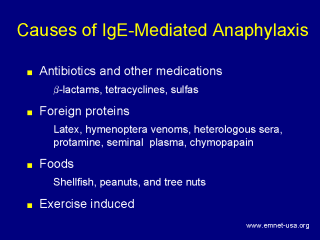| front |1 |2 |3 |4 |5 |6 |7 |8 |9 |10 |11 |12 |13 |14 |15 |16 |17 |18 |19 |20 |21 |22 |23 |24 |25 |26 |27 |28 |29 |30 |31 |32 |33 |34 |35 |36 |37 |38 |39 |40 |41 |42 |43 |44 |45 |review |
 |
Allergens causing
IgE-mediated anaphylaxis are mostly proteins, although most drug allergens
are haptens. The most common drug allergens are the b
-lactams (penicillins and cephalosporins) and the sulfas, but virtually any
antibiotic can cause anaphylaxis, as well as most any medication.
Intra-operative anaphylaxis may be caused by antibiotics, parenteral
anesthetic agents (especially the muscle relaxants), and latex. Many foreign proteins have been associated with anaphylactic reactions including latex (by contact, inhalation, ingestion and parenteral routes), Hymenoptera venoms, heterologous serum proteins, protamine, seminal fluid, and chymopapain. Latex has become a particularly important cause of anaphylaxis since its initial description in the late 1980s. Approximately 7-10% of health care professionals and 28-67% of patients with spina bifida or other urogenital diseases may manifest allergic symptoms when exposed to latex-containing equipment or products, such as balloons or condoms. The most common food allergens are also the most common causes of anaphylaxis: peanuts and tree nuts, shellfish and fish, and sometimes milk, eggs, seeds and even some fruits and vegetables (e.g. kiwi, avocado). |